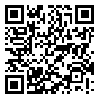Volume 25, Issue 5 (8-2018)
RJMS 2018, 25(5): 19-28 |
Back to browse issues page
Download citation:
BibTeX | RIS | EndNote | Medlars | ProCite | Reference Manager | RefWorks
Send citation to:



BibTeX | RIS | EndNote | Medlars | ProCite | Reference Manager | RefWorks
Send citation to:
Nejatbakhsh samimi L, Fallahpour M, Khoshmirsafa M, Baharloo R, Jorbozehdar P, Mousavi S A J et al . Hormone replacement therapy: an effective approach in regulation of TH1-relatted responses in women suffering from allergic asthma. RJMS 2018; 25 (5) :19-28
URL: http://rjms.iums.ac.ir/article-1-5154-en.html
URL: http://rjms.iums.ac.ir/article-1-5154-en.html
Leila Nejatbakhsh samimi 

 , Morteza Fallahpour
, Morteza Fallahpour 
 , Majid Khoshmirsafa
, Majid Khoshmirsafa 
 , Rasool Baharloo
, Rasool Baharloo 
 , Paria Jorbozehdar
, Paria Jorbozehdar 
 , Seyed Ali Javad Mousavi
, Seyed Ali Javad Mousavi 
 , Reza Falak *
, Reza Falak * 




 , Morteza Fallahpour
, Morteza Fallahpour 
 , Majid Khoshmirsafa
, Majid Khoshmirsafa 
 , Rasool Baharloo
, Rasool Baharloo 
 , Paria Jorbozehdar
, Paria Jorbozehdar 
 , Seyed Ali Javad Mousavi
, Seyed Ali Javad Mousavi 
 , Reza Falak *
, Reza Falak * 


Iran University of Medical Sciences, Tehran, Iran , Falak.R@iums.ac.ir
Abstract: (5463 Views)
Background: The pattern of incidence of asthma varies with age and sex, as females suffer more than males. Some asthmatic women report premenstrual exacerbation of asthma symptoms as well as variation of its severity during pregnancy, thus it is believed that sex hormonal changes could affect asthma. Hormone Replacement Therapy (HRT) is a routine and accepted procedure which is used for treatment of several cases such as irregular periods, hirsutism, menopausal manifestations, acne, osteoporosis and amelioration of the symptoms in some autoimmune disease. HRT could reduce the magnitude of variations in estrogen and progesterone over the menstrual cycle. According to increased asthma prevalence among women than men and regarding to expression of estrogen and progesterone receptor on lung and immune cells, we aimed to determine the effects of 17β-estradiol (E2) and progesterone (P4) alone and in combination form on expression of T-bet and IFN-ɣ cytokine secretion, in correlation with Th1 cell subset of Peripheral Blood Mononuclear Cells (PBMC) (as crucial cells that could affect cytokines’ balance) in asthmatic patients versus non-asthmatic healthy controls.
Methods: The diagnosis of asthma was confirmed on the basis of clinical symptoms and detection of allergen specific IgE. Then PBMCs were isolated and cultivated in 24-well plates in the presence or absence of 1% phytohemagglutinin (PHA), 10-8 M of estrogen and 10-6 M of progesterone, followed by mRNA isolation. After reverse transcription, real-time quantitative PCR was performed to evaluate the expression level of T-bet. We also measured the concentration of the related cytokine (IFN-ɣ) in supernatants by ELISA.
Results: The expression of T-bet as well as secretion of IFN-ɣ which is a Th1 related cytokine was significantly increased when a combination of both hormones were applied in case group compared to controls [Median: 84.04 (IQR: 77.32-177) and Median: 71.52 (IQR: 68.85-84.04) pg/ml respectively], however, treatment with these hormones alone did not show any significant effects.
Conclusion: We concluded that, treating PBMCs with estrogen and progesterone alone or in combination as an in vitro example of HRT, has stimulatory effect on Th1 cells’ behavior that may have a role in improving (sometimes worsening because of the complex role of CD8+T cells) of allergic asthma symptoms. It is crucial to clarify the effect of these hormones on differentiated T helper cell population, which requires more studies to understand the effect of sex hormones on allergic asthma.
Methods: The diagnosis of asthma was confirmed on the basis of clinical symptoms and detection of allergen specific IgE. Then PBMCs were isolated and cultivated in 24-well plates in the presence or absence of 1% phytohemagglutinin (PHA), 10-8 M of estrogen and 10-6 M of progesterone, followed by mRNA isolation. After reverse transcription, real-time quantitative PCR was performed to evaluate the expression level of T-bet. We also measured the concentration of the related cytokine (IFN-ɣ) in supernatants by ELISA.
Results: The expression of T-bet as well as secretion of IFN-ɣ which is a Th1 related cytokine was significantly increased when a combination of both hormones were applied in case group compared to controls [Median: 84.04 (IQR: 77.32-177) and Median: 71.52 (IQR: 68.85-84.04) pg/ml respectively], however, treatment with these hormones alone did not show any significant effects.
Conclusion: We concluded that, treating PBMCs with estrogen and progesterone alone or in combination as an in vitro example of HRT, has stimulatory effect on Th1 cells’ behavior that may have a role in improving (sometimes worsening because of the complex role of CD8+T cells) of allergic asthma symptoms. It is crucial to clarify the effect of these hormones on differentiated T helper cell population, which requires more studies to understand the effect of sex hormones on allergic asthma.
Type of Study: Research |
Subject:
Immunology
Send email to the article author




